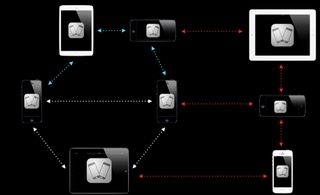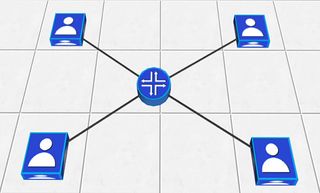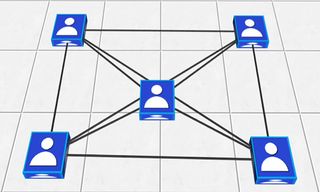Multipeer, meshed networks, and why risk managers will love them

Apple's gotten a lot of attention recently for iOS 7's multipeer networking frameworks. I covered them briefly in my enterprise and education overview back in September 2013 when iOS 7 first launched but they're worth a closer look. Multipeer networking makes use of Bluetooth, Infrastructure Wi-Fi (like a Wi-Fi Hotspot), and Peer-to-Peer Wi-Fi (also called Wi-Fi Direct) to create a peer-to-peer meshed network. Once the network has been established, people on that network can share content including messages (think IM), resources (think documents), or stream content. If you have used AirDrop to share pictures or other content with others, you have already used Multipeer Connectivity without knowing it. This is something risk managers in enterprise are going to love, and here's why!
How does multipeer connectivity work?
Multipeer Connectivity allows an app to create a network, and allow others to join it. Once they join the network, they can share content, stream content (like audio or video), and chat.
When iOS7 or later devices are connecting to the peer-to-peer meshed network, they make use of any of the available radios including Bluetooth or Wi-Fi. If there is no available Infrastructure Wi-Fi network (like a Wi-Fi Hotspot), the device will use Peer-to-Peer Wi-Fi (aka Wi-Fi Direct) to join the mesh network.
In fact, when developers create apps to take advantage of the Multipeer Connectivity Framework, they are abstracted from the entire networking processes itself. The framework takes care of automatically selecting the best radio to use (as long as the user has it enabled) and connecting to the network. This means that app developers do not need to be network experts, they just need to build great apps.

iOS7 or later devices can be members of more than one peer-to-peer network session, and iOS7 or later devices can bridge connectivity between members of the same peer-to-peer network session.
If we look at the image below we can see that the iPhone on the bottom right has its Wi-Fi radio enabled, but not its Bluetooth radio. The iPhone on the top has its Bluetooth radio enabled but not its Wi-Fi radio. The iPhone on the bottom left has both its Bluetooth and Wi-Fi radios enabled.
The iPhone on the bottom right can communicate with the iPhone on the bottom left using Wi-Fi. The iPhone on the top can communicate with the iPhone on the bottom left using Bluetooth. However the iPhone on the bottom right can also communicate with the iPhone on the top because the iPhone on the bottom right is acting as a bridge. All of this connectivity is taken care of automatically by the Multipeer Connectivity Framework of iOS7.
Master your iPhone in minutes
iMore offers spot-on advice and guidance from our team of experts, with decades of Apple device experience to lean on. Learn more with iMore!

How is multipeer connectivity a meshed network?
Most of us are familiar with a hub-and-spoke network like a Wi-Fi Hotspot or our Wi-Fi network at home. In fact cellular networks are also hub-and-spoke networks. As the name implies, each device on the network connects to all other devices on the network via a central hub as you can see in the diagram below. With a hub-and-spoke network, if the hub does down, no devices can communicate. This is the single point of failure.

On a meshed network, all devices can communicate directly with each other, with no need for a central hub as we can see in the diagram below.

The benefit of a meshed network is that devices on that network do not need a central hub to direct traffic. There is no single point of failure that can stop communications and all devices can communicate with each other freely.
iOS7 Multipeer networks also theoretically have no range limit. Because all devices can communicate with all other devices, and with the added benefit that any device can bridge communications, as long as a device is in-range of at least one other device, communications can remain established.
Why will risk managers be happy?
Risk Managers, amongst other things, spend a lot of time figuring out how to keep a company or government agency working in a disaster. If there is a natural or man-made disaster that knocks out cell towers and Wi-Fi Hotspots, how do companies or government agencies keep communicating with their staff? If cell towers are down, nobody can make calls, but more importantly, nobody can communicate in any way.
With the Multipeer Connectivity Framework of iOS7, apps can be built that take advantage of the meshed network. These apps can provide Instant Messaging (IM), streaming content (probably audio), and updates to documents like evacuation plans, and other important documents.
Imagine employees being able to continue doing their job by remaining in-touch with co-workers and management via IM. Imagine companies or government agencies being able to stream important information via audio to all employees.
iOS7 Multipeer networks can also be encrypted so that information remains private within each network. In addition, authentication can be mandated so that each device must provide login information to become part of the network. These last two features are extremely important to companies and government agencies because while the idea of a meshed network is great, if you cannot secure it, it is useless.
The bottom line
In our hub-and-spoke cellular data and Wi-Fi Hotspot world, we have always been at the mercy of the hub. No hub, no communications. Meshed networks are not new and have been around for decades, however they have not been applied to mobile communications the way they have been in iOS7. Apple has provided a framework that does all of the heavy lifting for developers, allowing them to exploit the power of the meshed network without having to become network experts themselves.
Meshed networks are entirely possible on other platforms including BlackBerry, Android, and Windows Phone/Windows Surface RT, because all of those devices include Bluetooth and Wi-Fi radios, however the operating systems themselves do not have the frameworks in-place to make developing apps that utilize meshed networks easily. For app developers to achieve what can be done on iOS7, they would need to build their own meshed network framework, in addition to the app they wanted to build. This is not an impossible task, however it greatly complicates the process.
To see the possibilities of iOS7’s Multipeer Connectivity Framework, take a look at the FireChat app. It utilizes this technology to offer Instant Messaging even when there is no cellular or Wi-Fi coverage.
Craig Johnston is a Mobile Strategist at NTT DATA and has been designing and managing large scale enterprise networks since 1989, including massive BlackBerry, iPhone, and iPad deployments in Fortune 500 companies. An avid podcaster and writer, you can find his books on Amazon and follow him on Twitter @ibanyan.

iPad Air 6 in larger size ‘leaked’ by over-enthusiastic case manufacturer — ESR preps for the 12.9-inch model and new iPad Pro, ahead of rumored May launch

Apple's huge AI iPhone upgrade will be entirely on-device to start with — 'Full details' expected at WWDC 2024 with iOS 18 ahead of iPhone 16

This hidden iPhone feature puts your friends and family's locations directly into the Maps app using Find My
Most Popular





